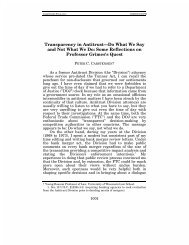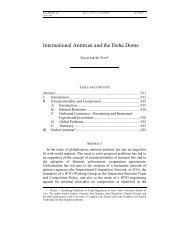An Essay Review of Nuechterlein and Weiser's Digital Crossroads
An Essay Review of Nuechterlein and Weiser's Digital Crossroads
An Essay Review of Nuechterlein and Weiser's Digital Crossroads
- No tags were found...
Create successful ePaper yourself
Turn your PDF publications into a flip-book with our unique Google optimized e-Paper software.
<strong>Review</strong> <strong>of</strong> Network Economics Vol.7, Issue 3 – September 2008<br />
Besides the costly legal battles (including countless state-level proceedings) <strong>and</strong><br />
uncertainty spawned by the Act, the technical <strong>and</strong> operational challenges <strong>of</strong> unbundling<br />
proved substantial. Traditional telephone networks were designed as integrated systems to<br />
serve end users, <strong>and</strong> it took considerable time <strong>and</strong> effort to create the new wholesale<br />
arrangements to serve competitors as required by the Act. For example, the Act did not<br />
foresee the need for “operations support systems” – electronic interfaces between<br />
competitors <strong>and</strong> the incumbent for functions such as ordering <strong>and</strong> billing – yet establishing<br />
such systems proved a key sticking point for providing access to UNEs or resale. Physical<br />
unbundling <strong>of</strong> loops through hot cuts also proved fairly slow <strong>and</strong> costly, <strong>and</strong> competitors’<br />
use <strong>of</strong> this UNE-L strategy ended up quite limited. 12<br />
Finally, as the authors emphasize, the circuit-switched telephone network is being<br />
superseded by developments largely unforeseen in the Act: the rise <strong>of</strong> packet-switched<br />
networks <strong>and</strong> broadb<strong>and</strong> Internet access to residential consumers, where cable companies<br />
<strong>of</strong>fer a powerful alternative to telephone companies. This is highly relevant to the Net<br />
Neutrality debate.<br />
4.5 The “net neutrality” controversy<br />
The debate over Net Neutrality is complex, but I will sketch its key aspects (see also Wu<br />
<strong>and</strong> Yoo, 2006). In its current version, the controversy is over what constraints, if any,<br />
should be placed on residential broadb<strong>and</strong> access providers in managing <strong>and</strong> pricing<br />
Internet traffic. 13 Traditionally, the transmission quality <strong>and</strong> pricing <strong>of</strong> Internet traffic was<br />
largely uniform, regardless <strong>of</strong> origin, content or destination. Unlike the circuit-switched<br />
telephone network, where intelligence resided largely in the network core, the Internet<br />
functioned more as a decentralized “dumb network”: routers passively directed data<br />
packets to the next router <strong>and</strong> intelligence was concentrated at the network edge with end<br />
users – consumers <strong>and</strong> providers <strong>of</strong> content or applications (“applications” for brevity).<br />
This “end-to-end” architecture is hailed by many Internet advocates for removing control<br />
from network operators. They fear that deviations from this model could allow operators to<br />
engage in detrimental discrimination <strong>and</strong> gain excessive control <strong>of</strong> Internet applications,<br />
<strong>and</strong> they call for regulation to enforce “Net Neutrality”.<br />
The operational meaning <strong>of</strong> the term, however, is far from clear. Conceptually, it<br />
suggests nondiscriminatory access for applications to Internet transmission. But what does<br />
that entail When some Internet traffic requires different network performance than others<br />
– in delay, “jitter” (variation in delay), or packet loss – uniform treatment is not neutral. 14<br />
12<br />
The FCC (2007a) reports that the number <strong>of</strong> unbundled loops at the end <strong>of</strong> 1999 was about 1 million,<br />
rising to 4.2 million at the end <strong>of</strong> 2002 <strong>and</strong> staying roughly flat through 2006. (For comparison, unbundled<br />
loops-with-switching, as in the UNE-P, peaked at 17 million in June 2004.) CLECs achieved greater<br />
penetration using their own last-mile facilities: from 2.7 million lines at the end <strong>of</strong> 1999 to 6.5 million at the<br />
end <strong>of</strong> 2002 <strong>and</strong> 11.1 million by the end <strong>of</strong> 2006. Much <strong>of</strong> this growth came from use <strong>of</strong> coaxial cable lines<br />
to provide telephone service, mainly to residential customers using VoIP. Cable lines rose from 0.3 million<br />
in 1999 to 3.1 million at the end <strong>of</strong> 2002 <strong>and</strong> 6.8 million at the end <strong>of</strong> 2006.<br />
13<br />
<strong>An</strong> earlier dispute centered on whether cable companies had to <strong>of</strong>fer “open access” to cable modems for<br />
unaffiliated ISPs, as the telephone companies were obliged with DSL under the FCC’s Computer II rules.<br />
The Supreme Court’s Br<strong>and</strong> X decision <strong>of</strong> 2005 stated that cable companies were not obliged <strong>and</strong>, for<br />
competitive parity, the FCC rapidly followed in its Wireline Broadb<strong>and</strong> Order by relieving telephone<br />
companies <strong>of</strong> their obligations. (See section 5 below.) Despite some predictions <strong>of</strong> doom <strong>and</strong> gloom, there is<br />
little evidence thus far that these rulings have threatened the vitality <strong>of</strong> the Internet.<br />
14<br />
For this reason, the traditional model is more accurately described as “Net Uniformity”.<br />
428





